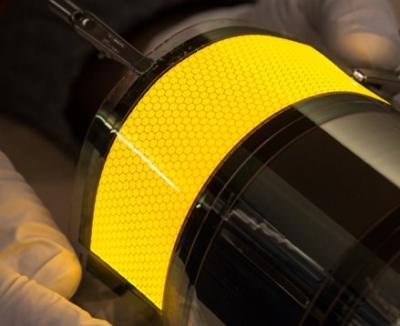The â¬11-million 3-years European Flex-o-Fab project was launched in January 2013 with an aim to help commercialize flexible OLEDs. The researchers working on this project have now successfully fabricated a flexible OLED prototype in a roll-to-roll (R2R) process.

The OLED prototype (shown above) was produced on a PET plastic film, and the researchers say this is a significant breakthrough on the way to commercial production. It uses technologies developed as part of the Flex-o-Fab project in addition to the Holst Centre's own high-performance flexible barriers for organic electronics.
The Holst Centre says that its R2R barriers have a similar performance to regular (sheet-to-sheet, or S2S) barriers. Researchers at Holst successfully produced over 2.5 kilometers of R2R barrier film based on a single inorganic layer with water vapor transmission rates (WVTR) lower than 10-5 g/m2 per day on commercial-grade PET foil.
The process used to create the OLED prototype used conventional commercial equipment (for example DuPont Teijin PET Film and Henkel adhesives) - and interestingly the panel was actually produced at several locations (Holst Centre in the Netherlands, Philips in Germany and the Ãcole Polytechnique Fédérale de Lausanne inSwitzerland).
The Flex-o-Fab consortium members are: Holst Centre / TNO (Project coordinator), Philips, Orbotech, the Institute of Microengineering, Ãcole Polytechnique Fédérale de Lausanne (EPFL), Henkel Electronics Materials N.V, SPGPrints, Epigem, Tampere University of Technology, Roth & Rau Microsystems, Dupont Teijin Films and CSEM.

